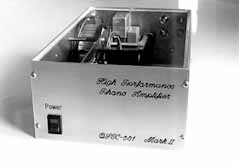Background
Click on the picture to get a larger view. The front view of the original QSX Amplifier.
Click on the picture to get a larger view. The original printed circuit board of the QSX Amplifier, only one channel.
A long time go
This phono amplifier design did I make a long time ago. The amp at the pictures has done service, almost every day since 1986! Good quality, isn't it? I'm very proud of it, despite the overkill, see down below. I got the inspiration of this paralleling technique of the input transistors from the magazine Elektor, some issue in the 80's but this fact has been known long before this.
Why did I design this amplifier?
Reason no. 1:
A friend of mine was searching for the perfect sound but not at any cost. He asked me to design an esoteric and orthodox moving magnet amplifier.
My friend had a turntable of a fairly good quality (changed from a Pioneer to a german Dual 505. He also switched the pickup to a better one (Ortofon VMS 20) but the sound quality wouldn't come. The sound was without life. The explanation was the built-in phono amp. This poor little amp was loaded with anti-emc stuff and the opamp was also a joke. The receiver was a simple model from Denon, rather good actually except of the phono amp.
My goal was to make a killer amp without to a very low cost. The performance should be outstanding! If you look at technical data maybe you agree.
Reason no. 2:
At that time I was a university student and I felt it was very interesting to combine theory with real life experience.
Reason no. 3:
17 years later I felt that the amp was rather timeless and worth publishing. Back then I didn't have the budget for making professional pcb's which I have now. I have had real fun when I soldered these industrial pcb's and it's looking nice too.
Reason no. 4:
Now 5 years later after my first internet publishing this amp is still my favorite. It represents for me a "timeless design".
VERY IMPORTANT:
This amp is an overkill and pure craziness, I know, but my friend and I are alone in having this unique amp (we are not alone anymore...). You can build a very good amp with NE5534, LT1115, LT1028, AD797, etc. to a fraction of the cost but it's not the same feeling. Why do some people like tubes? You know what I'm talking about.
It's a challenge to make the best possible sound quality there is with a minimum of components. It's very true if you want to sell the product and earn some money but on the other hand it's fun to ignore everything what's called sanity and live out your wildest dreams. Since I wrote this text I have created a design statement which I stay true to.
Although I agree to a certain extent what Mr. Nelson Pass says, I do believe that you get better results if you eliminate the bad behaviors of some components, transistors mainly. As always, if you know more about the inner life of the components, you'll get more control over the final result.
It was very fulfilling to have full control over the design process. All parameters, except the noise are determined by passive components only. I have tailored every detail in the performance. Every part in the amp have been thoroughIy analyzed and tested. I haven't tried to reduce the amount of components in order to get knowledge of what the component minimum are. After all the components are very cheap. I have used transistors for 3 cents!
At the left you can read a very true statement from Nelson Pass. (Take also a good look at his web site because he has lots of cool designs.)
This text comes from Nelson Pass at Pass Labs , and the A40 amp project:
The Pass A40 Power Amplifier
The Audio Amateur 4/78 by NELSON PASS



